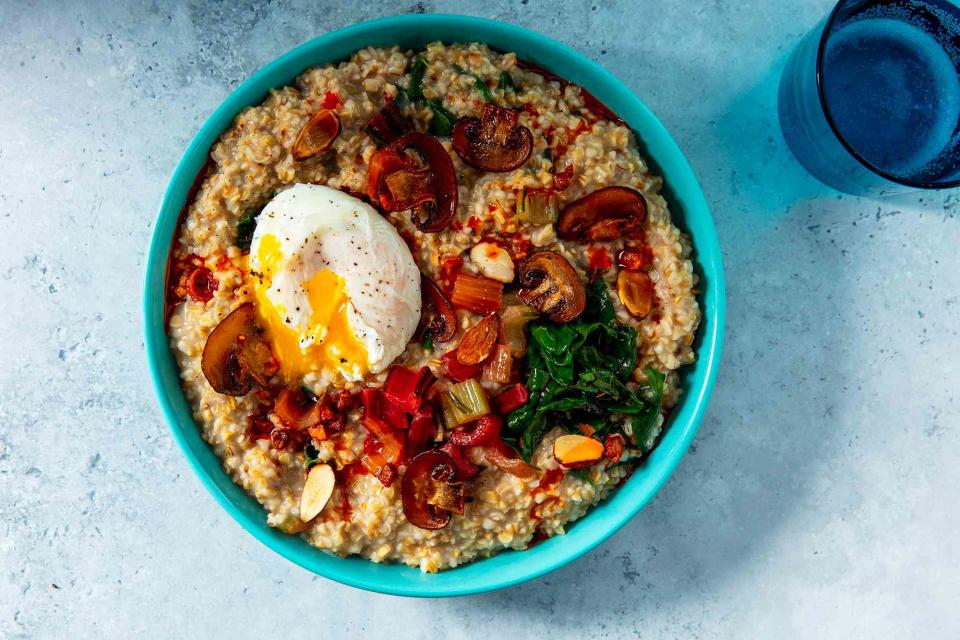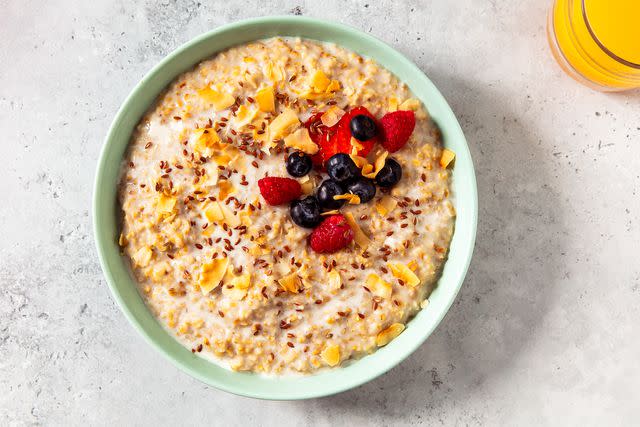How to Eat Oats Every Day and Never Get Bored
There are endless possibilities in a bowl of oats. Here’s how to transform oatmeal into a sweet or savory dish you can enjoy every day.

Matt Taylor-Gross / Food styling by Amelia Rampe
Every February for the past five years, I’ve challenged myself to change up my daily bowl of oats. I eat it differently each day of the month, and then I share a snap of it with folks on the internet using the hashtag #28daysofoatmeal. What started as a simple exercise in bringing focus and regularity to my Instagram feed has become — to my surprise — a giant love letter to this humble hot breakfast’s creative potential. I’ve learned that many of us eat our oats on autopilot, out of a sense of ritualized duty. But I’ve also seen firsthand that it’s easy to break free from that rut. Here are some of my lessons for making better, more varied bowls of daily oats.
How to toast oats
My strong preference is for steel-cut oats, which have a fortifying, chewy texture that I’ll choose any day over the mush of rolled or quick-cooking instant oats. But whatever kind of oats you use, toasting them before adding any cooking liquid amplifies their comforting aroma and nutty, sweet flavor. And since it only adds an extra couple of minutes to the process, I consider this step to be mandatory.
Just melt a little pat of butter in a saucepan over medium heat, and once the foam settles down, add your oats. Stir to coat the oats in the butter and then toast them, swirling or stirring the pan often, until they are fragrant and have even darkened a shade, about five minutes. Watch them carefully so that they don’t burn; adjust the heat if needed.
Think beyond water
Oats are naturally quite creamy, thanks to being such a starchy grain, but incorporating whole milk into the cooking liquid makes them even richer. This tactic also helps to create a delicious, decadent richness, with a consistency that’s akin to rice pudding. For me, one part milk to three parts water is the sweet spot, but other cooks use more, even cooking their oats in just milk.
:
That said, it’s also worth considering cooking your oats in other types of liquids. Tea, broth or stock, coffee — even something like carrot juice — all add new flavorful directions. Swapping out your liquid will make your oats less of a neutral base for toppings if you plan to stash away leftovers (see below), and is still a fun way to experiment.
For every one part oats, you’ll need four parts liquid for steel-cut oats, or two parts liquid for rolled oats. Once you’ve added your liquid to the saucepan and it’s come to a boil, reduce the heat to a gentle simmer and partially cover the pan. Cook steel-cut oats for 15 to 20 minutes, until they’re tender and as thickened as you like, stirring occasionally; rolled oats will cook in five to seven minutes. Remember that you can always add more liquid to thin your oats, or cook them longer if you’d like them thicker.

Matt Taylor-Gross / Food styling by Amelia Rampe
Cook large batches
The internet offers an abundance of suggestions for making the process of cooking steel-cut oatmeal easier, quicker, and more hands-off, from covering them with boiling water and soaking them overnight; to assembling them in your Instant Pot, pressure cooker, or slow cooker; or baking them in the oven. It’s true that steel-cut oats require more time to cook than rolled or instant oats, but still, we’re only talking about 20 minutes. None of the purportedly time-saving methods I’ve tried have offered a meaningful shortcut, so I stick to cooking them on the stove.
But something that steel-cut oats do very well is reheat. So make a big batch once or twice a week, and then quickly reheat it on your busy mornings. One cup of steel-cut oats typically yields about three ample or four smaller servings, so you can just double or triple that as necessary for your household.
:
Know that they will thicken considerably as they cool, going from soft to set in the space of about 30 minutes. When you reheat them, either on the stovetop or in the microwave, you’ll need to stir in additional water or milk to loosen the consistency.
Raid your leftovers
If you’re new to savory oatmeal, get ready! Likening your oats to other soft, spoonable cooked grains like congee or polenta instantly unlocks their savory potential, inspiring myriad topping ideas beyond brown sugar and cinnamon. Think scallions, soy sauce, and a boiled, fried, or poached egg; hot sauce or fresh chiles, kimchi, cheese, cooked greens; tomato sauce, roasted eggplant, tahini … the possibilities really are endless.
And in this regard, remember that oatmeal is an extremely efficient receptacle for odds and ends that otherwise might go to waste. That little tub of leftover Chinese takeout, the lingering cup of roasted vegetables, or spoonful of wilted greens? Put ‘em on your oats. Then complement those flavors just as you would at the dinner table, with good olive oil or chile oil, flaky salt and freshly ground black pepper, a spritz of lemon or vinegar, a dusting of hard cheese… you get the idea. Get creative, and enjoy your oats.

